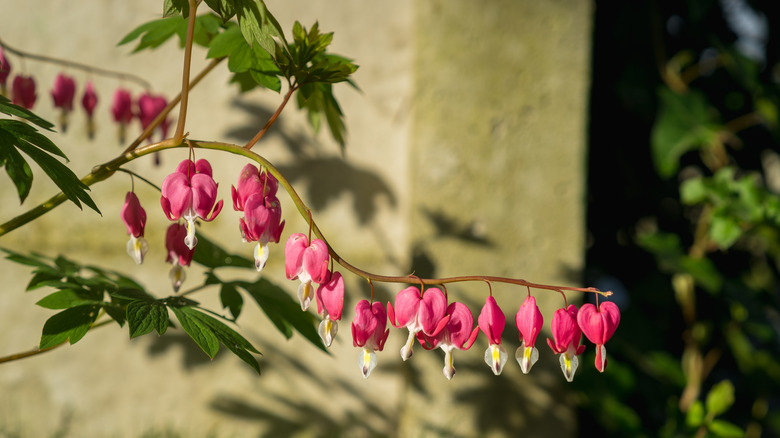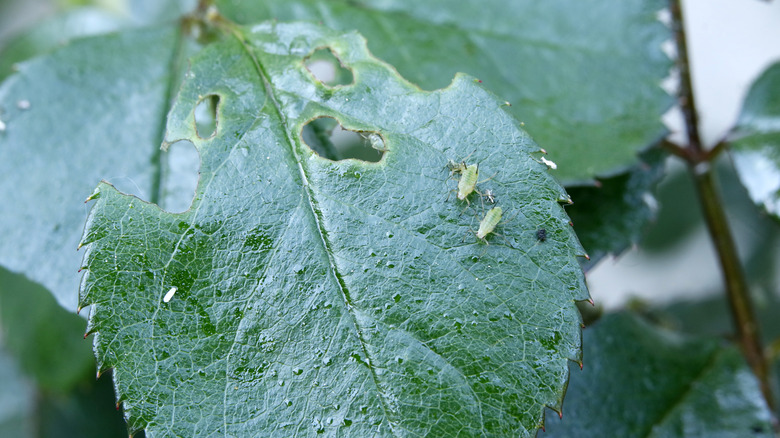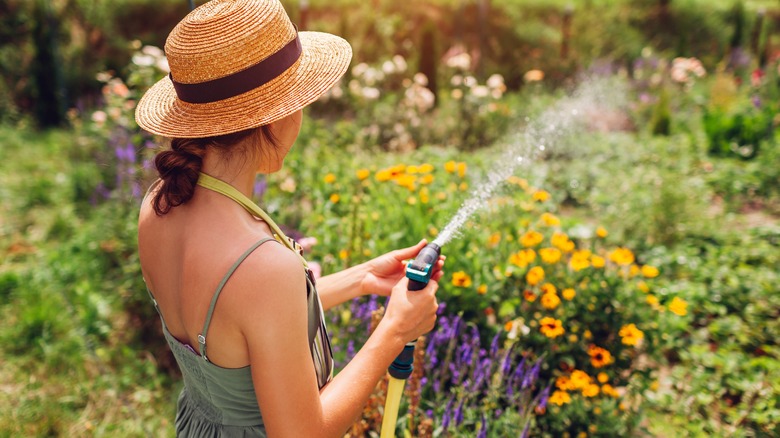Signs Your Bleeding Hearts Have A Pest Problem (& How To Get Rid Of Them)
The vibrant and moody bleeding hearts plant (Dicentra spectabilis) is prized for its striking aesthetics and romantic petal shape. It's the dramatic and colorful plant you can grow both indoors and outdoors. But even well-loved bleeding hearts can fall susceptible to insistent pests, eager to make themselves right at home in your plant's leaves and soil.
Bleeding hearts are a member of the poppy family that flourish in USDA zones 2 to 9 beginning in the spring. They bloom in an array of colors, from soft, snowy white to bright fuchsia. Bleeding hearts are considered to be a hardy and resistant plant. They are threatened by relatively few pests but can still be affected by slugs and aphids. These infestations can arise in both indoor house plants and outdoor gardens. Luckily, there are warning signs to look out for and preventative measures to take to ensure your bleeding hearts live to beat another day.
Discoloration, sticky sap residue, and ragged leaves that resemble Swiss cheese are all indicators you could be dealing with a pest problem. Thankfully, these common pests can often be eradicated using common household items that are readily available. Early-stage aphid infestations can be treated using simple ingredients like dish soap and water, while the most common methods of slug removal include setting a beer trap to entice and drown them, and donning a pair of gloves and picking them out by hand.
Checking your bleeding hearts for a pest infestation
The first step to eradicating a potential infestation is thoroughly checking your plant for pests often. Inspect individual leaves for yellowing, curling, or discoloration. You may also encounter physical damage to the leaves, like holes or signs of feeding around the edges. Additionally, check near the roots for any signs of mold in the plant's soil.
Aphids are pesky green insects that can be seen with the naked eye and feed on the sap in the plant's stems and leaves. Check underneath leaves for any aphid populations that are hiding in the shade. They leave behind a sticky excrement called honeydew that can leave a mess on both the plant itself and surrounding surfaces. Another warning sign of an aphid problem is a black, grimy mold with a soot-like appearance.
Slugs, meanwhile, are slimy mollusks that like to feed on plant tissue from flowers, leaves, and stems, leaving behind holes and chew marks. Bleeding hearts prefer shadier, moist conditions, which slugs also find ideal. Slugs thrive in wet and dark climates, making bleeding hearts the perfect habitat to settle down in.
How to treat and prevent pests in bleeding hearts
Pest infestations can stunt a bleeding heart plant's growth or cause severe damage. The best way to avoid pest damage to your beloved flowers is by taking proactive steps to prevent infestations from quickly escalating. Regularly checking on your drainage and the dampness of the soil is a great way to make sure conditions aren't overly moist.
If you do spot aphids, you can use anything from insecticides to just dish soap and water in a spray bottle to treat the plant. Aphids can also be physically removed by a gardening hose on a low setting, but this should be done with care to avoid damaging any blossoms.
The easiest way to remove slugs is simply by handpicking them out with gloved hands. You can also purchase traps and copper barriers to prevent slugs from feeding in your garden beds. Another simple way to trap them is by burying a small container of beer so that it's mostly level with the soil line. The smell of the yeasty alcohol will lure the slugs into the trap, where they will be left to drown. Whether you decide to go the more homeopathic route or take a trip to your local gardening center for a more aggressive treatment, there are solutions that can be tailored to your needs to ensure your bleeding hearts are not hosting unwelcome visitors.


